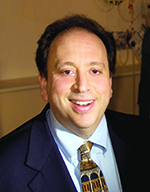November 20, 2010 - By Tracie White

Glenn Chertow
More frequent dialysis — six times a week versus the conventional three times a week — results in improved heart structure and self-reported physical health for patients with kidney failure, according to a new study led by a researcher at the Stanford University School of Medicine published online Nov. 20 in the New England Journal of Medicine.
The randomized clinical trial compared daily dialysis treatment (six days a week) to the routine three days a week — which has been prescribed for the treatment of kidney failure patients for the past 40 years — by measuring its effects on cardiovascular health and quality of life.
Both factors were found to improve significantly with the six-day-a-week treatment plan.
“The theory was that by dialyzing more frequently, the patient could avoid the ‘highs’ and ‘lows’ of three-days-a-week dialysis,” said Glenn Chertow, MD, chief of the Stanford nephrology division and lead author of the study. “Kidneys work seven days a week, 24 hours a day. You could imagine why people might feel better if dialysis were to more closely mimic kidney function. But you have to factor in the burden of additional sessions, the travel and the cost.”
The study also showed that frequent dialysis improved control of hypertension (high blood pressure) and hyperphosphatemia (high levels of phosphate in the blood), two conditions that affect the majority of patients with kidney failure.
Frequent dialysis was also associated with an increase in the number of procedures undertaken to maintain the vascular access, an important potential risk of more-frequent cannulation (inserting tubes into the body).
“This is really exciting,” said Alan Kliger, MD, clinical professor of nephrology at Yale University and senior author of the study. “This is the first randomized, controlled study in dialysis in over 30 years to show significant results. Measurements were significantly better in daily dialysis.”
Dialysis is a life-extending procedure that for most patients with kidney failure involves sitting in a chair at a treatment center three times a week connected to an artificial kidney machine. Small amounts of blood are slowly cleansed by exchanging fluid and electrolytes across a membrane during each three- to four-hour session.
Dialysis treatments sustain the lives of nearly 400,000 U.S. residents at a cost of $75,000 to $100,000 per patient per year. Most medical insurance plans including Medicare cover only the conventional three dialysis sessions per week. Clearly, doubling the number of sessions would be more expensive.
Researchers stopped short of recommending that all dialysis patients increase the number of dialyzing sessions based on the results of the study, instead emphasizing that treatment plans should be determined on a case-by-case basis.
“I’m certainly not going to recommend six times a week for all my patients,” said Chertow, who is also a professor of medicine at Stanford. “One size does not fit all. For some patients with kidney failure, no dialysis is the right treatment. For others, it’s three times a week in-center; for others, it’s home-based dialysis; for others, perhaps six times a week.”
The nephrology research community has been searching for ways to improve dialysis because of high mortality rates, generally 10 times that of the general population. Patients also frequently suffer from heart disease, anemia, malnutrition, depression and physical and cognitive impairment. And despite improvements in dialysis technology, these outcomes haven’t improved much since dialysis became available decades ago.
The study began in 2006, with a total of 245 dialysis patients randomized to either the three-day-a-week or six-day-a-week treatment plan for one year. The length of the sessions decreased from about three to four hours to about two-and-a-half to three hours for patients who were dialyzing more frequently.
In order to measure changes in cardiovascular disease, a common problem for dialysis patients, researchers took magnetic resonance images of their hearts at both the beginning and the end of the one-year treatment period to measure any changes in the size of the heart muscle. It’s known that dialysis patients can suffer from a thickening of the heart muscle that leads to higher mortality rates. Researchers measured left ventricular mass and found a decrease of 13.8 percent in the patients who had dialysis six days a week.
Another method used for measuring health outcomes was a questionnaire that patients filled out at the start of the study and at the year’s end, asking them for an assessment of their health-related quality of life including an in-depth look at their physical abilities both before and after the study.
“Both results were significantly better in daily dialysis,” Kliger said.
“One of the challenges will be figuring out which types of patients are likely to benefit from which types of treatment,” Chertow said. “This doesn’t mean every patient with kidney failure should receive dialysis six days a week. As with Stanford’s focus on personalized medicine, we need to create individualized dialysis treatment plans.”
The study was funded by the National Institutes of Health, the National Institutes of Diabetes and Digestive and Kidney Diseases and the Centers for Medicare & Medicaid Services, with additional support from DaVita Inc., Dialysis Clinics Inc., Fresenius Medical Care AG & Co., Renal Advantage Inc., Renal Research Institute LLC and Satellite Healthcare Inc. Chertow has served on the board of directors of Satellite Healthcare and on the scientific advisory board for DaVita, both of which are dialysis companies.
Information about Stanford’s Department of Medicine, which also supported the study, is available at http://medicine.stanford.edu/.
About Stanford Medicine
Stanford Medicine is an integrated academic health system comprising the Stanford School of Medicine and adult and pediatric health care delivery systems. Together, they harness the full potential of biomedicine through collaborative research, education and clinical care for patients. For more information, please visit med.stanford.edu.